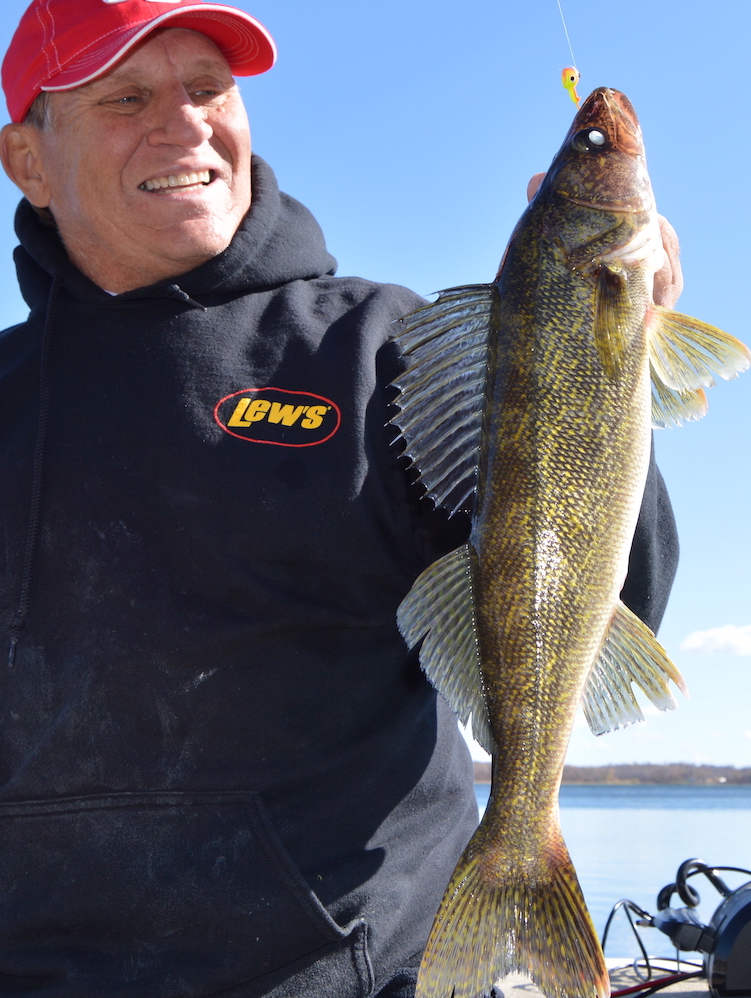Early Ice Walleye Fishing Ideas

Early Ice walleyes
Find ‘em in the fall, catch ‘em in the winter!
By Mike Frisch
The best ice fishing of my winter fishing career happened a few years back on a lake near my home in central Minnesota. This small, shallow lake is a stocked walleye fishery that often produces good walleye fishing in spring and then again in fall. The previous spring and fall on this lake had, in fact, seen a very good walleye bite. The fall fishing, in particular, was outstanding!
From mid-October until late November, I had a small area that produced numbers of “eaters” and several “overs” (fish over 20-inches) on nearly every outing. Jigs and minnows pitched to remnant weeds along the edge of a tapering flat was the productive pattern. The weeds in the “spot on the spot” stayed green well into fall, held baitfish, and drew walleyes and other gamefish too.
The good fishing of that fall lasted until November 21. That day I dodged ice chunks on the way to the good area, caught fish there, and then put the boat away for the season after the fishing trip. Ten days later, 4 to 6 inches of ice covered the 5- to 7-foot water. But the walleyes didn’t seem to care, as they were still there and still biting.
I tell this story to illustrate a couple key points about early ice walleyes. First, the early ice bite can be very good as the walleyes are often still feeding aggressively before going into a mid-winter funk. Second, fall fishing spots that held good numbers of walleyes will often be productive at early ice as well.
In this particular example, the presence of green weeds was important. Other irregularities, like points and turns or differences in bottom composition (sand to mud, for example), might be the draw for the fish on other waters. Whatever the reason, where you find them in fall is often where they’ll be in December.
Finding good numbers of fish is key to early ice success. A couple other fundamentals are important now too. First, since the ice is thin and often still clear, it’s a good idea to get to your fishing spot early, get set up, and be ready before the fishing action starts.
Often the best fishing action happens early morning and again in the evening during the change from night to day and vice versa in the evening. Being there before the action starts and getting set up can help minimize movement and noises that might scare the fish.
In addition to being quiet, I find fishing aggressive lures like jigging spoons most productive at first ice. A jigging spoon appeals to the aggressive nature of early ice walleyes as it can be fished aggressively to attract roaming walleyes and then fished slower to trigger bites from interested walleyes.
Jigging spoons are traditional baits that most anglers have in their winter tackle boxes. A glide-style bait is another aggressive jigging bait that has been in existence for many years too, but with their popularity exploding in recent years. These lures have accounted for several recent open water walleye tournament wins, but they can be dynamite under the ice as well.
The new Tikka Mino is a glide bait I had success with last fall and can’t wait to put to use this winter! This bait has the swimming, darting action of a panicked minnow, comes in a bunch of great colors, and is equipped with super sharp hooks as well.
Regardless whether you prefer a jigging spoon or one of the new glide baits, your chances for walleye fishing success at early ice can probably be enhanced by using some of the aforementioned suggestions. Targeting productive fall spots, getting to them early, and then fishing aggressively might just put a bunch of walleye gold on the ice for you soon!
Mike Frisch hosts the popular Fishing the Midwest TV series. Visit www.fishingthemidwest.com or follow Fishing the Midwest on Facebook for more "fishy" stuff.
PHOTO - Mike Frisch with a late fall walleye. Good fall fishing spots will usually produce walleyes at first ice too!

